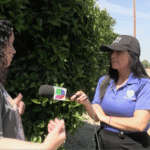Student Activism
Start with a Statement
Before everything else, before recruiting members or raising money, you need to have a definitive vision. With a clear mission statement, everyone who is involved will know what the group will be trying to achieve.
Find a Facilitator
Because every school has different procedures for student groups, it’s really important to let at least one staff member know that you are interested in starting this group. A staff member will likely be able to lead you through the administrative steps to officially starting the group.
Get Students Involved
There are many ways to get other students involved, from posting flyers around school, writing in the school paper or newsletter, speaking to students during breaks, or speaking during the morning announcements. Stay in contact with your group outside of meetings. Instead of sending an email, pick up the phone and make more of a personal connection with your supporters.
Don’t Stop
It’s easy to lose steam with something “extra” like an advocacy group. The most important thing when starting up a student group is to keep the fire burning. Keep variety in your events and meetings. If you feel yourself burning out, take some time to reevaluate why you wanted to get involved in the first place.
Pet shop/puppy mill subcommittee for existing group
If your school already has an animal rights group, consider starting a pet shop/puppy mill committee.
Tabling
Tabling is a great way to inform others about the abuses of animals in pet stores and puppy mills. With so many opportunities to table, here are just a few examples:
- Concerts
- Student Activity Fairs
- Festivals and Street Fairs
- Social Awareness Conferences
Start a Street Team
Leafleting
The best places to leaflet are public areas with high foot traffic. Our favorite locations are:
- Outside of subway, train, or bus stations.
- On college campuses
- Near high schools around lunchtime or just before or after school
- Outside of major events like concerts, exhibitions and sports games (preferably as people are leaving)
Postering and Flyering
Fliers are often seen on bulletin boards and kiosks. But you can post them in the hallway, at the library or around campus. Don’t forget about cafés or clubs that you frequent, music stores, gyms, rec centers, supermarkets and even bathroom stalls at the mall.
Protest pet shops
Get Organized
Ask a few friends/supporters to help you organize the protest. This will help you delegate responsibly and get more people involved. Once you are organized decide on which type of protest you are having (a silent vigil or chanting).
Pick A Date & Time
Find a time and date that you feel people would be able to attend. We found that noon on Saturday or after 6pm on a weekday work well. Also decide on the duration of the protest. One hour is typical but two hours allows more scheduling flexibility for protesters and media.
Location, Location, Location
To make things go as smoothly as possible, choose a location that has a public sidewalk and good foot/vehicle traffic. If the pet store is in a mall or shopping strip, stay on a public sidewalk so you won’t be accused of trespass.
Spread The Word
By having a team of people helping working on the protest, it’s even easier to get the word out. Make and post flyers, call friends, write letters to newspapers, post bulletins on MySpace, contact the media by sending a press release and then following up with a phone call.
Be Prepared
In case the local media arrives it’s important to know what to say. Ask a friend to help you practice what you would say to the media. The media is especially interested in consumer complaints. Try to find consumers who purchased sick pet shop puppies. Then ask them to attend the protest and speak to the media.
Get Creative
What’s a protest without signs? Take time making signs with photos. Use legible writing. Be sure to distribute fact sheets and brochures.
The Day Of
We recommend arriving 15 -20 minutes early on the day of the protest. Being early has perks: you can get the signs out and be prepared to greet the first comers. Designate one person to shoot photos and video during the protest. Share your photos and footage with CAPS. If there are people you don’t recognize, introduce your self to them and thank them for coming.
And Don’t Forget
Organizing your own protest on behalf of the animals is making a difference. The animals need your voice. It’s important to stay in contact with the people who came to the protest; tell them how important their voice is for the animals when you make follow up calls to thank everyone who came.
Investigate
More than 90 percent of pet shop puppies come from puppy mills. Most pet shops deal directly with USDA licensed “B” dealers (brokers), who obtain their puppies from breeders who typically run substandard facilities (puppy mills). Many of these breeders have USDA “A” licenses. Some breeders are exempt from licensing because they don’t have more than three breeding females and derive more than $500 in gross income from the resale of dogs.
Inspect
Things to look for
- sickness
- injury
- over crowding
- insufficient food/water
- insects
- accumulation of feces
Document
Record information on a notepad or send a text message to a friend. Take photos with a small camera or cell phone.
Ask
Obtain the source of the puppies. Some brokers provide pedigrees to pet shops. Pedigrees, which are lineage charts for purebred dogs, usually have a broker’s seal in the bottom left corner and the breeder’s name on top. Look at several puppies and have your friends do the same. If the puppy has a pedigree, ask to see it. Some pet shops, such as Petland, have puppy folders, which contain pedigrees and other records, such as breeder names. Some states, such as California require pet shops to provide breeder and broker names, both verbally and in writing. Make sure you get the town and state for all breeders and brokers.
Report




